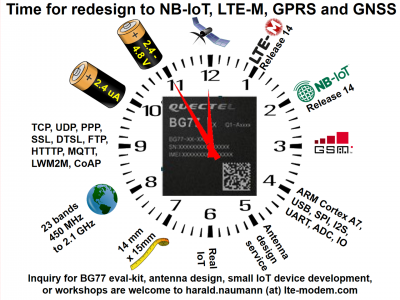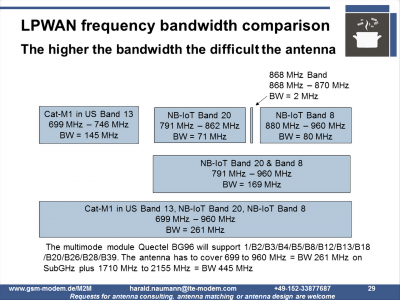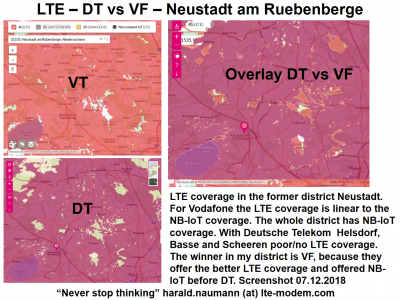In order to save development and approval costs, the antenna, frequency bands, ground plane size and housing should be carefully designed at the beginning of development. If the company lacks in-house experience with radio, antennas and worldwide approval, we recommend consulting an external consultant. The following text is intended to make you think. I use real radio networks in my district. I’m using the Quectel BG95 and BG77 for the consideration, because with its 20 frequency bands, option on internal Wi-Fi and GNSS exterm it offers many possibilities for applications. I explain it in detail with the BG95-M3 because supports NB-IoT, LTE-M with fallback to GPRS.
Cellular Bands with Quectel BG95-M3
NB-IoT and GSM with BG95-M3
The BG95-M3 covers 20 bands for NB-IoT and LTE-M plus 4 bands on GSM. The bands supportedby the BG95 are marked yellow in the table below. For the European bands, we used blue characters. Band 31 with its 450 MHz is very special and not very popular in public LTE networks. In Germany utility companies run closed LTE networks in the 450 MHz range. NB-IoT in Europe is mainly on band 8 and 20. Deutsche Telekom in Germany is running a dual band NB-IoT network on SubGHz band 8 and 20. Vodafone in Europe is on band 20. It is common to run NB-IoT on SubGHz bands.
LTE-M with Quectel BG95-M3
You could run LTE-Mat SubGHz but in parallel to LTE 1800 in EU or LTE 1900 as well. For Germany I expect band 8 an band 20 from 791 MHz to 960 Mhz. I analysed the LTE network in my district Neustadt am Rübenberge. The fallback for voice for LTE 800 is GSM 900. This means LTE 800 and GSM 900 are on the same antenna mast and the same physical antenna and some BTS on single RAN. One BTS is able to run everything in parallel. LTE-M is mainly a slow LTE CAT 1. The operator will use the same BTS for LTE-M as well. This means we get LTE-M in the same bands as NB-IoT. LTE 1800 and LTE 2600 are run in the bigger cities to achieve 450 Mbit per second and more for the smartphones. In my dreamy little town we are happy that we have LTE on a carrier with 150 Mbit per second, 1 Mbit at the edge of the cell and phone calls on GSM. On top of that we have coverage in over 30 villages with GSM, LTE and NB-IoT.
The old district Neustadt am Rübenberge is well supplied with NB-IoT from Vodafone. The coverage map for LTE from Vodafone and Deutsche Telekom is overlaid in the graphic. Telekom does not offer NB-IoT yet. So we are testing with Vodafone for now.
Antenna matching or Quectel BG95-M3
If you want us to match your antenna for the Quectel BG95 or BG77, other cellular modules or even LoRaWAN or Sigfox you have to consider the required bands. If we are to match for the USA and Australia or even develop customer-specific antennas, then the cellular frequency bands must be named with the order for antenna matching. In order to save costs for antena matcing, antenna development and approval, a radio module like BG95 or BG77 can be limited with control commands. For Neustadt am Rübenberge this means that NB-IoT in band 20 and GSM in band 8 are enough. If you want to work with all network operators in Germany together, then you should choose band 8, band 20 and band 3 with NB-IoT (band 8 and 20), GSM (band 8 and 3) LTE-M (band 8, 20 and 3). For the antenna it stays at 3 bands and matching for 3 bands. However, 7 control measurements on the harmonic waves are necessary for radio approval bt the notified body. If we execute an order for matching or antenna development, then we measure the bands at 2100 MHz and 2600 MHz in Europe at the same time. However, if only bands 8, 20 and 3 are required, then we do not try to optimize the upper bands. If you know exactly that you only want to sell your device in Europe, then you can choose the remaining bands and do without multiband in the USA or bands above 2100 MHz. The return loss curve will look better for an antenna for 3 cellular bands than for 5 or even more bands. Less is more. You get the rest of the remaining is better. If the bandwidth of the antenna becomes limited due to a small ground plane, then this works better with 3 bands than with 5 bands.
Testing antennas for Quectel BG95 and BG77
The best way to do this is to mount the embedded antenna in the housing on an empty PCB first. The data sheet of an antenna is only a rough guide. The antenna in the real world with a housing is always worse than on evaluation board of the manufacturer without a housing. Everyone always wants low-cost and 10 year life from the battery. Such a long-life battery quickly costs 20 USD. Investing 1 USD more for a better antenna you will often save 10 USD on the battery because of a lower power requirement. a 3 dB antenna gain often means half the current during transmission and thus half the energy to send a message. The antenna is the key to success, improving range and up to 50% battery savings. If the antenna is perfectly adapted on the motherboard as a printed circuit antenna then you can save the cost of a chip antenna. A customized, stamped bent metal surface often makes a very good antenna and the costs for the development are saved as well as the battery cost again.
Offer for antenna matching or antenna developement
In order to make an offer for matching or development of an antenna we need:
– The frequency bands and the countries
– Type and name of the radio module
– Size of the board, equal to the size of the ground plane
– Application of the device
– Housing material or data sheet
– Battery, display and other metal parts in housing
– Planned installation type. We will simulate the ambient conditions
As stated in the introduction of this article, at the beginning of development you should carefully consider in which regions and bands you would like to sell your device. If the antenna or the size of the ground plane does not match the frequency band or the bandwidth of the band, an approval may not be possible. If there is no experience with radio approvals worldwide in your company, we will be happy to help you with advice on a small budget. In my function as Sales Director, my customers often receive basic advice free of charge. Inquiries for consulting, feasibility studies, development of IoT devices, matching of antennas or development of customized antennas are welcome at harald.naumann (at) lte-modem.com
Frequency band supported by Quectel BG95-M3
BG95-M3 LTE bands: B1, B2, B3, B4, B5, B8, B12, B13, B14, B17, B18, B19, B20, B25, B26, B27, B28, B31, B66, B71
BG95-M3 GSM band: B1, B2 B3, B5
Data sheets Quectel BG95 and BG77
| B and |
M ode |
ƒ (MHz) |
N
a m e |
Subset of band | Uplink (MHz) |
Down-
link |
Duplex spacing (MHz) |
Channel BW (MHz) |
| 1 | FDD | 2100 | IMT | 65 | 1920 – 1980 | 2110 – 2170 | 190 | 5, 10, 15, 20 |
| 2 | FDD | 1900 | PCS /GSM 1900 |
25 | 1850 – 1910 | 1930 – 1990 | 80 | 1.4, 3, 5, 10, 15, 20 |
| 3 | FDD | 1800 | DCS, GSM/LTE 1800 | 1710 – 1785 | 1805 – 1880 | 95 | 1.4, 3, 5, 10, 15, 20 | |
| 4 | FDD | 1700 | AWS | 66 | 1710 – 1755 | 2110 – 2155 | 400 | 1.4, 3, 5, 10, 15, 20 |
| 5 | FDD | 850 | Cellular GSM 850 / LTE 850 |
26 | 824 – 849 | 869 – 894 | 45 | 1.4, 3, 5, 10 |
| 7 | FDD | 2600 | IMT-E | 2500 – 2570 | 2620 – 2690 | 120 | 5, 10, 15, 20 | |
| 8 | FDD | 900 | Extended GSM / LTE 900 |
880 – 915 | 925 – 960 | 45 | 1.4, 3, 5, 10 | |
| 10 | FDD | 1700 | Extended AWS | 66 | 1710 – 1770 | 2110 – 2170 | 400 | 5, 10, 15, 20 |
| 11 | FDD | 1500 | Lower PDC | 74 | 1427.9 – 1447.9 | 1475.9 – 1495.9 | 48 | 5, 10 |
| 12 | FDD | 700 | Lower SMH | 85 | 699 – 716 | 729 – 746 | 30 | 1.4, 3, 5, 10 |
| 13 | FDD | 700 | Upper SMH | 777 – 787 | 746 – 756 | ?31 | 5, 10 | |
| 14 | FDD | 700 | Upper SMH | 788 – 798 | 758 – 768 | ?30 | 5, 10 | |
| 17 | FDD | 700 | Lower SMH | 12, 85 | 704 – 716 | 734 – 746 | 30 | 5, 10 |
| 18 | FDD | 850 | Lower 800 (Japan) | 26 | 815 – 830 | 860 – 875 | 45 | 5, 10, 15 |
| 19 | FDD | 850 | Upper 800 (Japan) | 26 | 830 – 845 | 875 – 890 | 45 | 5, 10, 15 |
| 20 | FDD | 800 | Digital Dividend (EU) / LTE 800 |
832 – 862 | 791 – 821 | ?41 | 5, 10, 15, 20 | |
| 21 | FDD | 1500 | Upper PDC | 74 | 1447.9 – 1462.9 | 1495.9 – 1510.9 | 48 | 5, 10, 15 |
| 22 | FDD | 3500 | 3410 – 3490 | 3510 – 3590 | 100 | 5, 10, 15, 20 | ||
| 24 | FDD | 1600 | Upper L?Band (US) | 1626.5 – 1660.5 | 1525 – 1559 | ?101.5 | 5, 10 | |
| 25 | FDD | 1900 | Extended PCS | 1850 – 1915 | 1930 – 1995 | 80 | 1.4, 3, 5, 10, 15, 20 | |
| 26 | FDD | 850 | Extended Cellular | 814 – 849 | 859 – 894 | 45 | 1.4, 3, 5, 10, 15 | |
| 27 | FDD | 800 | SMR | 807 – 824 | 852 – 869 | 45 | 1.4, 3, 5, 10 | |
| 28 | FDD | 700 | APT | 703 – 748 | 758 – 803 | 55 | 3, 5, 10, 15, 20 | |
| 29 | SDL | 700 | Lower SMH | N/A | 717 – 728 | N/A | 3, 5, 10 | |
| 30 | FDD | 2300 | WCS | 2305 – 2315 | 2350 – 2360 | 45 | 5, 10 | |
| 31 | FDD | 450 | NMT / LTE 450 | 452.5 – 457.5 | 462.5 – 467.5 | 10 | 1.4, 3, 5 | |
| 32 | SDL[A 11] | 1500 | L-Band (EU) | 75 | N/A | 1452 – 1496 | N/A | 5, 10, 15, 20 |
| 33 | TDD | 2100 | IMT | 39 | 1900 – 1920 | N/A | 5, 10, 15, 20 | |
| 34 | TDD | 2100 | IMT | 2010 – 2025 | N/A | 5, 10, 15 | ||
| 35 | TDD | 1900 | PCS (UL) | 1850 – 1910 | N/A | 1.4, 3, 5, 10, 15, 20 | ||
| 36 | TDD | 1900 | PCS (DL) | 1930 – 1990 | N/A | 1.4, 3, 5, 10, 15, 20 | ||
| 37 | TDD | 1900 | PCS | 1910 – 1930 | N/A | 5, 10, 15, 20 | ||
| 38 | TDD | 2600 | IMT-E | 41 | 2570 – 2620 | N/A | 5, 10, 15, 20 | |
| 39 | TDD | 1900 | DCS–IMT Gap | 1880 – 1920 | N/A | 5, 10, 15, 20 | ||
| 40 | TDD | 2300 | S-Band | 2300 – 2400 | N/A | 5, 10, 15, 20 | ||
| 41 | TDD | 2500 | BRS | 2496 – 2690 | N/A | 5, 10, 15, 20 | ||
| 42 | TDD | 3500 | CBRS (EU, Japan) | 3400 – 3600 | N/A | 5, 10, 15, 20 | ||
| 43 | TDD | 3700 | S-Band | 3600 – 3800 | N/A | 5, 10, 15, 20 | ||
| 44 | TDD | 700 | APT | 703 – 803 | N/A | 3, 5, 10, 15, 20 | ||
| 45 | TDD | 1500 | L-Band (China) | 50 | 1447 – 1467 | N/A | 5, 10, 15, 20 | |
| 46 | TDD | 5200 | U-NII | 5150 – 5925 | N/A | 10, 20 | ||
| 47 | TDD | 5900 | U-NII-4 | 5855 – 5925 | N/A | 10, 20 | ||
| 48 | TDD | 3500 | CBRS (US) | 3550 – 3700 | N/A | 5, 10, 15, 20 | ||
| 49 | TDD | 3600 | S-Band | 48 | 3550 – 3700 | N/A | 10, 20 | |
| 50 | TDD | 1500 | L?Band (EU) | 1432 – 1517 | N/A | 3, 5, 10, 15, 20 | ||
| 51 | TDD | 1500 | Extended L?Band (EU) | 1427 – 1432 | N/A | 3, 5 | ||
| 52 | TDD | 3300 | S-Band | 3300 – 3400 | N/A | 5, 10, 15, 20 | ||
| 65 | FDD | 2100 | Extended IMT | 1920 – 2010 | 2110 – 2200 | 190 | 5, 10, 15, 20 | |
| 66 | FDD | 1700 | Extended AWS (AWS?1–3) | 1710 – 1780 | 2110 – 2200 | 400 | 1.4, 3, 5, 10, 15, 20 | |
| 67 | SDL[A 11] | 700 | EU 700 | N/A | 738 – 758 | N/A | 5, 10, 15, 20 | |
| 68 | FDD | 700 | ME 700 | 698 – 728 | 753 – 783 | 55 | 5, 10, 15 | |
| 69 | SDL[A 11] | 2600 | IMT-E | N/A | 2570 – 2620 | N/A | 5 | |
| 70 | FDD | 2000 | AWS?4 | 1695 – 1710 | 1995 – 2020 | 295 – 300 | 5, 10, 15 | |
| 71 | FDD | 600 | Digital Dividend (US) | 663 – 698 | 617 – 652 | ?46 | 5, 10, 15, 20 | |
| 72 | FDD | 450 | PMR (EU) | 451 – 456 | 461 – 466 | 10 | 1.4, 3, 5 | |
| 73 | FDD | 450 | PMR (APT) | 450 – 455 | 460 – 465 | 10 | 1.4, 3, 5 | |
| 74 | FDD | 1500 | Lower L-Band (US) | 1427 – 1470 | 1475 – 1518 | 48 | 1.4, 3, 5, 10, 15, 20 | |
| 75 | SDL[A 11] | 1500 | L-Band (EU) | N/A | 1432 – 1517 | N/A | 5, 10, 15 20 | |
| 76 | SDL | 1500 | Extended L?Band (EU) | N/A | 1427 – 1432 | N/A | 5 | |
| 85 | FDD | 700 | Extended Lower SMH | 698 – 716 | 728 – 746 | 30 | 5, 10 | |
| 252 | SDL | 5200 | U-NII-1 | N/A | 5150 – 5250 | N/A | 20 | |
| 255 | SDL | 5800 | U-NII-3 | N/A | 5725 – 5850 | N/A | 20 | |


